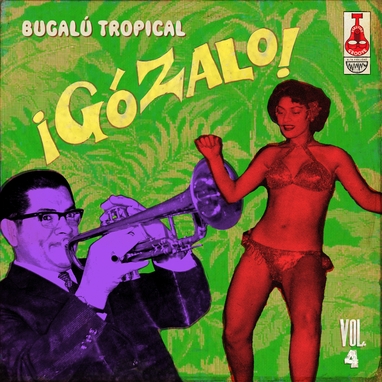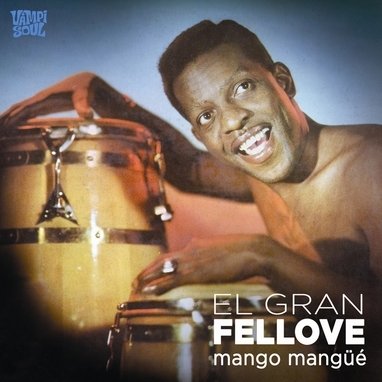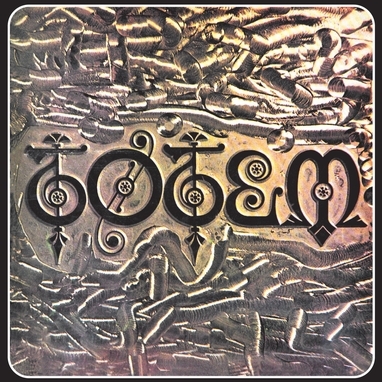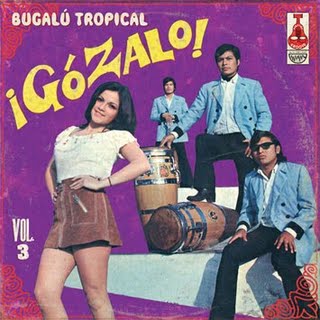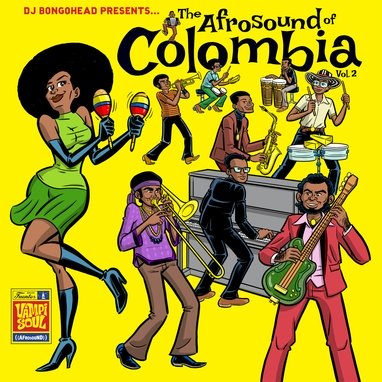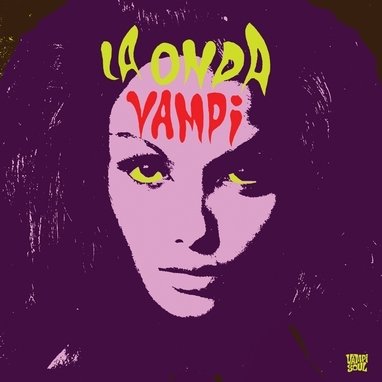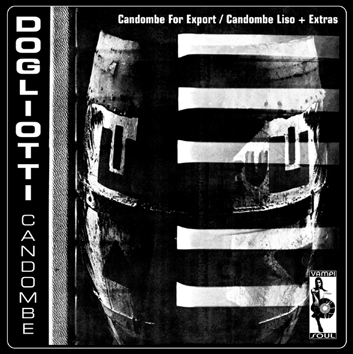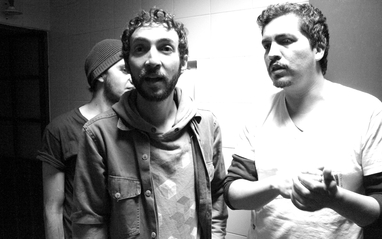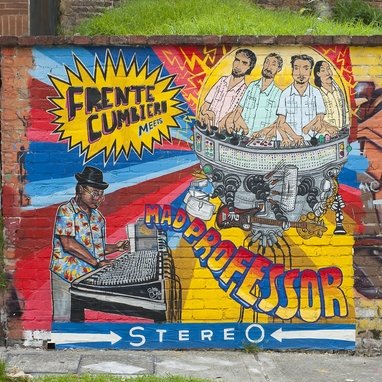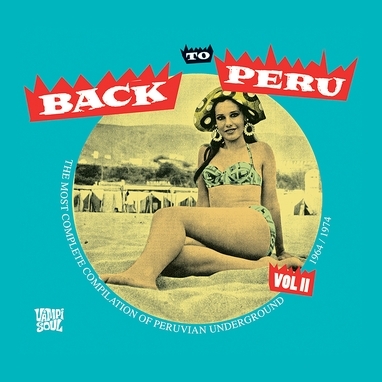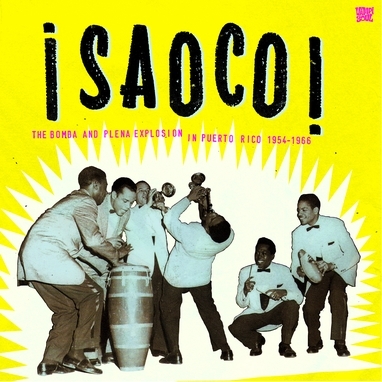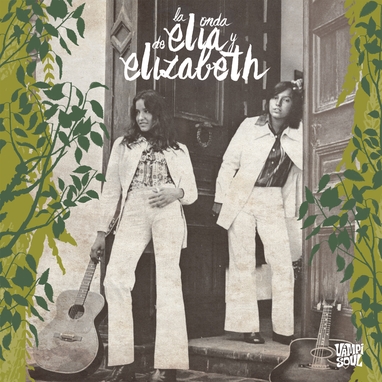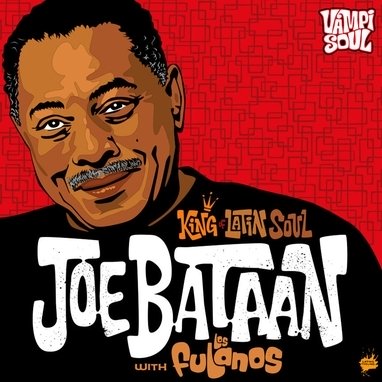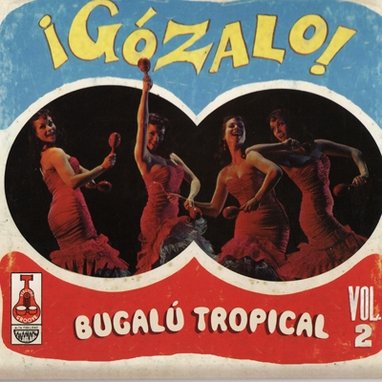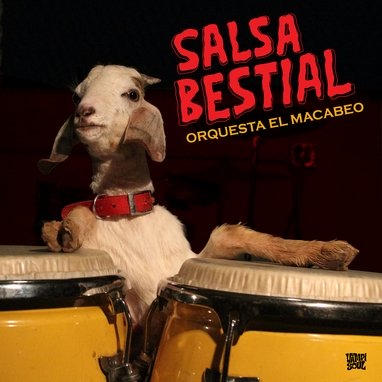VVAA
¡Gózalo! Bugalú Tropical Vol.4
Vampisoul
VVAA
¡Gózalo! Bugalú Tropical Vol.4
Volume 4 of our successful series of tropical Peruvian music of the 60s. An exciting, spicy mix of musical gems that fill in the link between the mambo era and the dawn of salsa in South America. Another great selection of tracks from a little known but essential period in the development of Latin Music. A terrific, dance-inducing mix of genres across 28 tracks: boogaloo, mambo, son, guaracha, cumbia. Features liner notes in Spanish and English by expert Carlos Torres Redondo plus photos and original artwork reproductions
When drawing the musical map of Latin America, the mistake is often made to identify the zone of influence of Afro-Latin music only around the Caribbean. It’s true that the great creators are Cuban and Puerto Rican, but when their music spread out across Latin America, similar scenes sprung up in other parts of the continent. It was during the 50s that the genre captivated Peru. Tropical orchestras appeared everywhere with a repertoire based on mambos, guarachas and, to a lesser extent, boleros and merengues. However, over the Afro-Cuban foundation they added diverse influences and reached a new sound, different from their inspiration. Within the core of the tropical music scene, the Sonora de Lucho Macedo clearly stands out; they were the first group of its kind in the middle of an environment exclusively populated by orchestras. The Sonora released more than 80 LPs and countless singles. Of all the ensembles, it had the greatest international projection. Beyond his irrefutable professional merits, Macedo’s essential contribution was to recruit musicians that later on would start the most important boogaloo groups. At times, Macedo’s career seems the backbone of this whole story. The first one to leave his band and go his own way was Joe Di Roma. Bongoist Ñiko Estrada left a little later to create his Sonora Antillana. From Macedo’s band also came double bass player José Pepe Hernández, percussionists Mario Allison and Coco Lagos, trumpet player Tito Chicoma and singer Charlie Palomares – almost all of the main artists of the golden age of boogaloo in the mid-60s, each of them a director of their own band. 1962 saw the arrival of Nilo Espinosa, a saxophonist with a solid academic formation and a deep knowledge of jazz. He started to record with his own orchestra and in 1965 he would form the group Los Hilton’s. The puzzle was completed with the self-taught pianist Otto de Rojas. They all knew each other from the hotels, parties and TV sets, but especially from the recording studio sessions. Although the main record labels, El Virrey, Sono Radio and Iempsa, also recorded tropical music, it was MAG, run by Manuel A Guerrero, which most focused on the genre. Lucho Macedo, once again, was the pioneer. In 1955 he already had a contract. All his disciples stayed at MAG and made a big part of the great recordings from the boogaloo era in the label’s studio. MAG possessed the best infrastructure. Guerrero used to take his recordings to Ecuador, Colombia, Venezuela, Puerto Rico, the United States, among other countries, and would sell them to foreign record labels. He chose the repertoire for the recordings himself. He built his own musical factory. MAG studio’s group of musicians in the 60s was rather eclectic. Some of them would come and go, but there was a core of players who became more or less the house band. The permanent members were Mario Allison, Coco Lagos and Nilo Espinosa. On trumpets were Tito Chicoma and Betico Salas; Alfredo Linares would sometimes play the vibraphone and was the most regular pianist. Víctor Fuentes, Melcochita and the multi-instrumentalist Charlie Palomares were in charge of the vocals. They all played for each other’s bands. The energy could be felt everywhere. The height of the tropical orchestras coincided with boogaloo. At that point the scenario had changed. The massive migration inland towards the capital brought along a radical change in popular music, giving birth to Peruvian cumbia, which also had a tropical foundation. The Afro-Cuban influence, without disappearing at all, left room for a Colombian influence. With the new decade the market was taken over by cumbia and salsa. An era had reached its end.
Productos relacionados
Volume 4 of our successful series of tropical Peruvian music of the 60s. An exciting, spicy mix of musical gems that fill in the link between the mambo era and the dawn of salsa in South America. Another great selection of tracks from a little known but essential period in the development of Latin Music. A terrific, dance-inducing mix of genres across 28 tracks: boogaloo, mambo, son, guaracha, cumbia. Features liner notes in Spanish and English by expert Carlos Torres Redondo plus photos and original artwork reproductions
When drawing the musical map of Latin America, the mistake is often made to identify the zone of influence of Afro-Latin music only around the Caribbean. It’s true that the great creators are Cuban and Puerto Rican, but when their music spread out across Latin America, similar scenes sprung up in other parts of the continent. It was during the 50s that the genre captivated Peru. Tropical orchestras appeared everywhere with a repertoire based on mambos, guarachas and, to a lesser extent, boleros and merengues. However, over the Afro-Cuban foundation they added diverse influences and reached a new sound, different from their inspiration. Within the core of the tropical music scene, the Sonora de Lucho Macedo clearly stands out; they were the first group of its kind in the middle of an environment exclusively populated by orchestras. The Sonora released more than 80 LPs and countless singles. Of all the ensembles, it had the greatest international projection. Beyond his irrefutable professional merits, Macedo’s essential contribution was to recruit musicians that later on would start the most important boogaloo groups. At times, Macedo’s career seems the backbone of this whole story. The first one to leave his band and go his own way was Joe Di Roma. Bongoist Ñiko Estrada left a little later to create his Sonora Antillana. From Macedo’s band also came double bass player José Pepe Hernández, percussionists Mario Allison and Coco Lagos, trumpet player Tito Chicoma and singer Charlie Palomares – almost all of the main artists of the golden age of boogaloo in the mid-60s, each of them a director of their own band. 1962 saw the arrival of Nilo Espinosa, a saxophonist with a solid academic formation and a deep knowledge of jazz. He started to record with his own orchestra and in 1965 he would form the group Los Hilton’s. The puzzle was completed with the self-taught pianist Otto de Rojas. They all knew each other from the hotels, parties and TV sets, but especially from the recording studio sessions. Although the main record labels, El Virrey, Sono Radio and Iempsa, also recorded tropical music, it was MAG, run by Manuel A Guerrero, which most focused on the genre. Lucho Macedo, once again, was the pioneer. In 1955 he already had a contract. All his disciples stayed at MAG and made a big part of the great recordings from the boogaloo era in the label’s studio. MAG possessed the best infrastructure. Guerrero used to take his recordings to Ecuador, Colombia, Venezuela, Puerto Rico, the United States, among other countries, and would sell them to foreign record labels. He chose the repertoire for the recordings himself. He built his own musical factory. MAG studio’s group of musicians in the 60s was rather eclectic. Some of them would come and go, but there was a core of players who became more or less the house band. The permanent members were Mario Allison, Coco Lagos and Nilo Espinosa. On trumpets were Tito Chicoma and Betico Salas; Alfredo Linares would sometimes play the vibraphone and was the most regular pianist. Víctor Fuentes, Melcochita and the multi-instrumentalist Charlie Palomares were in charge of the vocals. They all played for each other’s bands. The energy could be felt everywhere. The height of the tropical orchestras coincided with boogaloo. At that point the scenario had changed. The massive migration inland towards the capital brought along a radical change in popular music, giving birth to Peruvian cumbia, which also had a tropical foundation. The Afro-Cuban influence, without disappearing at all, left room for a Colombian influence. With the new decade the market was taken over by cumbia and salsa. An era had reached its end.
Productos relacionados
¡Gózalo! Bugalú Tropical Vol.4
Volume 4 of our successful series of tropical Peruvian music of the 60s. An exciting, spicy mix of musical gems that fill in the link between the mambo era and the dawn of salsa in South America. Another great selection of tracks from a little known but essential period in the development of Latin Music. A terrific, dance-inducing mix of genres across 28 tracks: boogaloo, mambo, son, guaracha, cumbia. Features liner notes in Spanish and English by expert Carlos Torres Redondo plus photos and original artwork reproductions
When drawing the musical map of Latin America, the mistake is often made to identify the zone of influence of Afro-Latin music only around the Caribbean. It’s true that the great creators are Cuban and Puerto Rican, but when their music spread out across Latin America, similar scenes sprung up in other parts of the continent. It was during the 50s that the genre captivated Peru. Tropical orchestras appeared everywhere with a repertoire based on mambos, guarachas and, to a lesser extent, boleros and merengues. However, over the Afro-Cuban foundation they added diverse influences and reached a new sound, different from their inspiration. Within the core of the tropical music scene, the Sonora de Lucho Macedo clearly stands out; they were the first group of its kind in the middle of an environment exclusively populated by orchestras. The Sonora released more than 80 LPs and countless singles. Of all the ensembles, it had the greatest international projection. Beyond his irrefutable professional merits, Macedo’s essential contribution was to recruit musicians that later on would start the most important boogaloo groups. At times, Macedo’s career seems the backbone of this whole story. The first one to leave his band and go his own way was Joe Di Roma. Bongoist Ñiko Estrada left a little later to create his Sonora Antillana. From Macedo’s band also came double bass player José Pepe Hernández, percussionists Mario Allison and Coco Lagos, trumpet player Tito Chicoma and singer Charlie Palomares – almost all of the main artists of the golden age of boogaloo in the mid-60s, each of them a director of their own band. 1962 saw the arrival of Nilo Espinosa, a saxophonist with a solid academic formation and a deep knowledge of jazz. He started to record with his own orchestra and in 1965 he would form the group Los Hilton’s. The puzzle was completed with the self-taught pianist Otto de Rojas. They all knew each other from the hotels, parties and TV sets, but especially from the recording studio sessions. Although the main record labels, El Virrey, Sono Radio and Iempsa, also recorded tropical music, it was MAG, run by Manuel A Guerrero, which most focused on the genre. Lucho Macedo, once again, was the pioneer. In 1955 he already had a contract. All his disciples stayed at MAG and made a big part of the great recordings from the boogaloo era in the label’s studio. MAG possessed the best infrastructure. Guerrero used to take his recordings to Ecuador, Colombia, Venezuela, Puerto Rico, the United States, among other countries, and would sell them to foreign record labels. He chose the repertoire for the recordings himself. He built his own musical factory. MAG studio’s group of musicians in the 60s was rather eclectic. Some of them would come and go, but there was a core of players who became more or less the house band. The permanent members were Mario Allison, Coco Lagos and Nilo Espinosa. On trumpets were Tito Chicoma and Betico Salas; Alfredo Linares would sometimes play the vibraphone and was the most regular pianist. Víctor Fuentes, Melcochita and the multi-instrumentalist Charlie Palomares were in charge of the vocals. They all played for each other’s bands. The energy could be felt everywhere. The height of the tropical orchestras coincided with boogaloo. At that point the scenario had changed. The massive migration inland towards the capital brought along a radical change in popular music, giving birth to Peruvian cumbia, which also had a tropical foundation. The Afro-Cuban influence, without disappearing at all, left room for a Colombian influence. With the new decade the market was taken over by cumbia and salsa. An era had reached its end.
Volume 4 of our successful series of tropical Peruvian music of the 60s. An exciting, spicy mix of musical gems that fill in the link between the mambo era and the dawn of salsa in South America. Another great selection of tracks from a little known but essential period in the development of Latin Music. A terrific, dance-inducing mix of genres across 28 tracks: boogaloo, mambo, son, guaracha, cumbia. Features liner notes in Spanish and English by expert Carlos Torres Redondo plus photos and original artwork reproductions
When drawing the musical map of Latin America, the mistake is often made to identify the zone of influence of Afro-Latin music only around the Caribbean. It’s true that the great creators are Cuban and Puerto Rican, but when their music spread out across Latin America, similar scenes sprung up in other parts of the continent. It was during the 50s that the genre captivated Peru. Tropical orchestras appeared everywhere with a repertoire based on mambos, guarachas and, to a lesser extent, boleros and merengues. However, over the Afro-Cuban foundation they added diverse influences and reached a new sound, different from their inspiration. Within the core of the tropical music scene, the Sonora de Lucho Macedo clearly stands out; they were the first group of its kind in the middle of an environment exclusively populated by orchestras. The Sonora released more than 80 LPs and countless singles. Of all the ensembles, it had the greatest international projection. Beyond his irrefutable professional merits, Macedo’s essential contribution was to recruit musicians that later on would start the most important boogaloo groups. At times, Macedo’s career seems the backbone of this whole story. The first one to leave his band and go his own way was Joe Di Roma. Bongoist Ñiko Estrada left a little later to create his Sonora Antillana. From Macedo’s band also came double bass player José Pepe Hernández, percussionists Mario Allison and Coco Lagos, trumpet player Tito Chicoma and singer Charlie Palomares – almost all of the main artists of the golden age of boogaloo in the mid-60s, each of them a director of their own band. 1962 saw the arrival of Nilo Espinosa, a saxophonist with a solid academic formation and a deep knowledge of jazz. He started to record with his own orchestra and in 1965 he would form the group Los Hilton’s. The puzzle was completed with the self-taught pianist Otto de Rojas. They all knew each other from the hotels, parties and TV sets, but especially from the recording studio sessions. Although the main record labels, El Virrey, Sono Radio and Iempsa, also recorded tropical music, it was MAG, run by Manuel A Guerrero, which most focused on the genre. Lucho Macedo, once again, was the pioneer. In 1955 he already had a contract. All his disciples stayed at MAG and made a big part of the great recordings from the boogaloo era in the label’s studio. MAG possessed the best infrastructure. Guerrero used to take his recordings to Ecuador, Colombia, Venezuela, Puerto Rico, the United States, among other countries, and would sell them to foreign record labels. He chose the repertoire for the recordings himself. He built his own musical factory. MAG studio’s group of musicians in the 60s was rather eclectic. Some of them would come and go, but there was a core of players who became more or less the house band. The permanent members were Mario Allison, Coco Lagos and Nilo Espinosa. On trumpets were Tito Chicoma and Betico Salas; Alfredo Linares would sometimes play the vibraphone and was the most regular pianist. Víctor Fuentes, Melcochita and the multi-instrumentalist Charlie Palomares were in charge of the vocals. They all played for each other’s bands. The energy could be felt everywhere. The height of the tropical orchestras coincided with boogaloo. At that point the scenario had changed. The massive migration inland towards the capital brought along a radical change in popular music, giving birth to Peruvian cumbia, which also had a tropical foundation. The Afro-Cuban influence, without disappearing at all, left room for a Colombian influence. With the new decade the market was taken over by cumbia and salsa. An era had reached its end.

